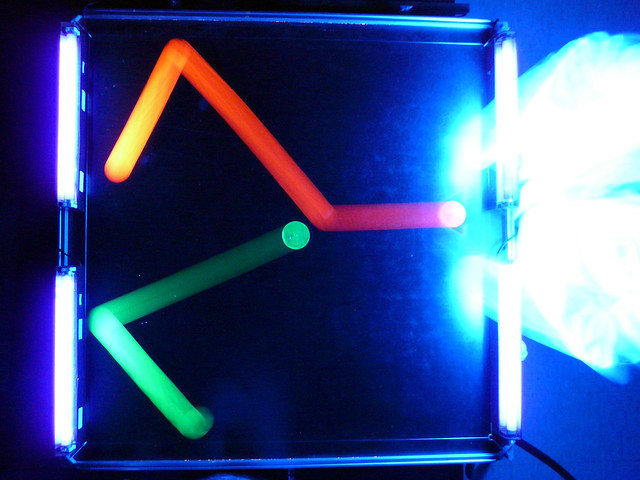Fun with Momentum and Impulse
http://www.flickr.com/photos/physicsclassroom/galleries/72157625280491634/
This collision between the red and green pucks in this photograph perfectly illustrates several concepts from our latest unit- impulse and momentum. The Law of Conservation of Momentum states that momentum before a collision equals momentum after a collision, assuming a closed system (no external forces) exists. But what is momentum? Commonly used to mean "hard to stop" or "on a roll", momentum in physics is a measure of effort needed to bring an object to rest. Momentum (p) equals mass times velocity. So for the perfectly elastic collision (perfectly elastic means that momentum is conserved as well as kinetic energy, because the objects bounce off each other with no energy loss) between the red and green pucks, conservation of linear momentum can clearly be seen. By throwing trigonometry and momentum vecors into the mix, we can apply these equations:
mRInitialvRInitial=mRedFinalvRedFinalcosθ1+ mGreenFinalvGreenFinalcosθ2
mRedFinalvRedFinalsinθ1+ mGreenFinalvGreenFinalsinθ2=0
where theta one is the angle between the path of the red puck after the collison and the path of the red puck before the collision, and theta two represents the angle between the green puck after and the red puck before. Just to complicate things, we can also use conservation of kinetic energy with this equation:
1/2mRvRedInitial2=1/2mGvGreenFinal2+1/2mRvRedFinal2
since kinetic energy equals 1/2 mass times velocity squared. Furthermore, the initial collision of the thingy used to hit the puck (official name?) and the puck is a great example of impulse. Impulse equals force times time, as well as change in momentum. The impluse imparted by the player pushing the puck for a certain period of time caused the puck to increase in momentum from zero to its mass times whatever velocity it had after being pushed into motion. A more interesting question would be the collision between each ball and the wall of the table. Was any momentum given to the table? Why does it appear that the red ball does not bounce off at the same angle at which it hit the wall? And how do pool players calculate such angles to set up shots involving multiple collisons?
Please ignore the really large picture below. I don't know how to make it go away!



0 Comments
Recommended Comments
There are no comments to display.